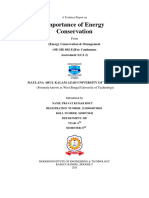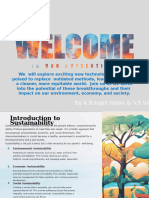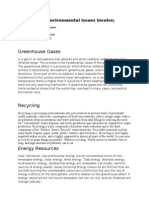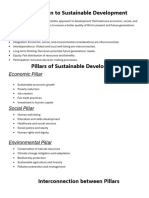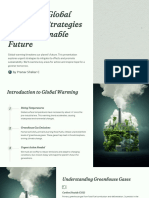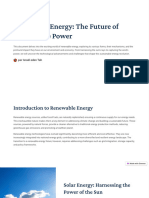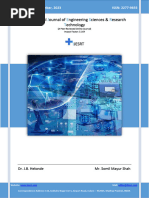0 ratings0% found this document useful (0 votes)
Sustainability
Sustainability
Uploaded by
YASIN CAFECopyright:
© All Rights Reserved
Available Formats
Download as PDF, TXT or read online from Scribd
Download as pdf or txt
Sustainability
Sustainability
Uploaded by
YASIN CAFE0 ratings0% found this document useful (0 votes)
Copyright
© © All Rights Reserved
Available Formats
PDF, TXT or read online from Scribd
Share this document
Did you find this document useful?
Is this content inappropriate?
Copyright:
© All Rights Reserved
Available Formats
Download as PDF, TXT or read online from Scribd
Download as pdf or txt
0 ratings0% found this document useful (0 votes)
Sustainability
Sustainability
Uploaded by
YASIN CAFECopyright:
© All Rights Reserved
Available Formats
Download as PDF, TXT or read online from Scribd
Download as pdf or txt
You are on page 1/ 15
Importance of Sustainability
1. Climate Change Mitigation:
Mitigating climate change
means reducing the flow of heat-
trapping greenhouse gases into the
atmosphere.
2. Resource Conservation: Resource
conservation means safeguarding
precious resources such as minerals,
wildlife, trees, water, and other
natural resources.
3. Ecosystem Preservation: Ecosystem
preservation is an effort to protect
the components in an ecosystem in
order to maintain its natural state. .
4. Human Health: Improve air and
water quality, reduce pollution.
5. Economic Growth: Create jobs,
stimulate innovation, and ensure
long-term prosperity.
Emerging Green Technologies:
Renewable Energy: Renewable energy is energy derived from natural sources
that are replenished at a higher rate than they are consumed. Sunlight and
wind, for example, are such sources that are constantly being replenished.
Renewable energy sources are plentiful and all around us.
Energy Storage: Energy storage can be categorized as chemical,
electrochemical, mechanical, electromagnetic, and thermal. Commonly, an
energy storage system is composed of an electricity conversion system, a
storage medium, and the balance of plant.
Sustainable transportation refers to low- and zero-emission, energy-efficient,
and affordable modes of transport, including electric and alternative-fuel
vehicles, as well as domestic fuels.
Green buildings: It incorporates measures that are environmentally friendly
and resource-efficient across the building lifecycle. The green buildings
concept aims to comprehensively minimize the negative impact and maximize
the positive impact a building has on its natural environment and human
occupants.
Water Resources Management (WRM) is the process of planning, developing, and
managing water resources, in terms of both water quantity and quality, across all
water uses.
Waste management is intended to reduce the adverse effects of waste on human
health, the environment, planetary resources, and aesthetics. The aim of waste
management is to reduce the dangerous effects of such waste on the environment
and human health.
Sustainable agricultural practices are intended to protect the environment,
expand the Earth's natural resource base, and maintain and improve soil fertility.
Carbon Capture and Utilization: Carbon capture and utilisation refers to a range
of applications through which CO2 is captured and used either directly (i.e. not
chemically altered) or indirectly (i.e. transformed) in various products.
Benefits of Emerging Green Technologies:
Emission reduction refers
to minimisation of the greenhouse gas
(GHG) emissions generated by an
individual, organisation, or country.
These gases include carbon dioxide
(CO2), methane, nitrous oxide, and
hydro fluorocarbons (HFCs).
Improved Energy Efficiency : Energy
efficiency is the use of less energy to
perform the same task or produce the
same result.
Water Conservation : Water
conservation is the practice of
using water efficiently to reduce
unnecessary water usage.
Waste Reduction : Waste reduction
is anything that reduces waste by using
less material in the first place. Reducing
waste can be as simple as using both
sides of a sheet of paper, using ceramic
mugs instead of disposable cups, or
buying in bulk rather than individually
packaged items.
Job Creation : the provision of
new opportunities for paid
employment, especially for
those who are unemployed.
Economic growth refers to an
increase in the size of a country's
economy over a period of time.
Enchanced Public health:
It improves our quality of life,
helps children thrive, reduces
human suffering and saves
money.
Increased Food Security: A
person is food insecure when
they lack regular access to
enough safe and nutritious food
for normal growth and
development and an active and
healthy life.
Challenges and Opportunities:
High Upfront Costs : One major barrier is that sustainability initiatives
often require significant upfront investments, while the returns may
take years to realize. Installation of renewable energy systems, green
building renovations, supply chain transformations, and other efforts
can be capital-intensive.
Infrastructure Development : Sustainable infrastructure
involves developing roads, buildings, energy and water infrastructure
with due consideration to economic, social and environmental
implications.
Policy and Regulation Frameworks: Regulatory frameworks are crucial
for setting a minimum threshold for sustainability practices. They
ensure that businesses and individuals adhere to specific standards
that mitigate environmental impacts, promote social equity, and
encourage economic sustainability.
Public Awareness and Education: Education is critical for promoting
sustainable development and improving the capacity of the people to
address environment and development issues.
Addressing challenges related to sustainable funding for science requires coordinated efforts
from government agencies, policymakers, research institutions, and the private sector to
streamline funding mechanisms, improve capacity-building initiatives, and foster a culture
of innovation and research excellence.
Collaboration and Partnerships: Sustainability partnerships can have a much larger impact
than the original intended goals of the two collaborating organizations.
Scaling Up Technologies: Sustainable scaling means optimising your resources, efficiency
and time to gradually build your business to create long-term success.
Integration with Existing Systems: Integrated Sustainability (IS) is a holistic view that
responds to the sustainability challenge by integrating self and contextual awareness and
analytical approaches with thought and action.
Real-World Examples
Tesla's Electric Vehicles and
Energy Storage Solutions
Tesla, Inc. is an American
multinational automotive and clean
energy company. Headquartered in
Austin, Texas, it designs,
manufactures and sells battery
electric vehicles, stationary battery
energy storage devices from home to
grid-scale, solar panels and solar
shingles, and related products and
services.
As a company, Tesla is dedicated to
renewable energy generation. Solar
energy, in particular is a focus area
for Tesla, and the company has
introduced innovative solar panels
and solar roof tiles for residential
and commercial use.
Google's Sustainable Data
Centers
A green data center, or sustainable
data center, is a service facility
which utilizes energy-efficient
technologies. They do not contain
obsolete systems (such as inactive
or underused servers), and take
advantage of newer, more efficient
technologies.
Google Data Centers are achieving
zero waste, leading in energy
efficiency, and running on
renewable energy. This is all a part
of our commitment to making a
positive impact on the
environment.
Copenhagen's Carbon-Neutral
District Heating System
The Danish capital has the world’s
largest district heating network. The
system serves 98% of Copenhagen’s
buildings. Over a 15-year period
ending in 2025, the Greater
Copenhagen Utility (HOFOR) will
make the system carbon neutral by
transitioning from coal, oil, and
natural gas to sustainable biomass.
The plan also aims to reduce energy
consumption in buildings and homes
through remote monitoring of
customers’ energy use. If a large
deviation occurs, the customer will be
alerted and she can review the
heating unit for errors and ensure
optimum settings and operation.
Finally, real-time monitoring of the
distribution system, and the use of
weather forecasts to ensure
operational efficiency, will reduce
heat losses in the district heating
system by 6% by 2025.
Costa Rica's Renewable Energy-
Powered Economy
The Costa Rican Institute of
Electricity (ICE) holds a monopoly
over electricity distribution and
generation in Costa Rica. There are
some exceptions where other public
institutions, private companies (Law
#7200) and co-operatives are
authorized by law to generate and
sell electricity.
The most relevant exception is the
National Energy and Light Company
(CNFL), which is a subsidiary of ICE.
Renewable energy in Costa Rica
supplied 99.78% of the energy
output for the entire nation in
2020. In 2018, 98% of its electrical
energy was derived from renewable
energy sources, about 72% of which
came from hydroelectric power and
15% from geothermal.
Future Outlook:
1. Increased Investment in Green Technologies
2. Advancements in Materials Science and Nanotechnology
3. Integration of Artificial Intelligence and IoT
4. Circular Economy Business Models
5. Global Cooperation and Knowledge Sharing
Conclusion
The importance of sustainability and emerging green
technologies cannot be overstated. As we continue to
innovate and adopt these solutions, we can mitigate
environmental challenges, ensure economic growth,
and create a liveable future for generations to come.
Would you like to explore specific
green technologies or
sustainability topics further?
Yes because Green tech involves the creation and use
of alternative fuels and less-harmful technologies,
aiming to protect the environment, repair
environmental damage, and conserve the Earth's
natural resources.
You might also like
- Excavator: Technical Manual Troubleshooting100% (2)Excavator: Technical Manual Troubleshooting224 pages
- Unit 2 Lesson 6.2 "E Transfers and Transformations": Answer KeyNo ratings yetUnit 2 Lesson 6.2 "E Transfers and Transformations": Answer Key25 pages
- The Domestic Politics Model: Nuclear Pork and Parochial InterestsNo ratings yetThe Domestic Politics Model: Nuclear Pork and Parochial Interests2 pages
- Sustainability and Emerging Green Technologies Are Crucial ForNo ratings yetSustainability and Emerging Green Technologies Are Crucial For15 pages
- P P PPPPPPPPPPPPPPPPPPPPPPPPPPPPPPPPPPPPPPPPPPPPPPPPPPPPPPPPPPPPPPPPPPPPPPPPPPPPPPPPPPPPPPPPPPPPPPPPPPPPPPPPPPP MP MPNo ratings yetP P PPPPPPPPPPPPPPPPPPPPPPPPPPPPPPPPPPPPPPPPPPPPPPPPPPPPPPPPPPPPPPPPPPPPPPPPPPPPPPPPPPPPPPPPPPPPPPPPPPPPPPPPPPP MP MP17 pages
- Sustainable Design Concepts for Building Services M1No ratings yetSustainable Design Concepts for Building Services M115 pages
- Energy-Essay If You Wish To Bear Fruits You Must Go To Your Roots."No ratings yetEnergy-Essay If You Wish To Bear Fruits You Must Go To Your Roots."2 pages
- 26900721042-Pravat Rout-Energy Conservation & management-MENo ratings yet26900721042-Pravat Rout-Energy Conservation & management-ME5 pages
- Sustainable Innovation: How Technology Is Driving The Green RevolutionNo ratings yetSustainable Innovation: How Technology Is Driving The Green Revolution2 pages
- Energy Conservation Refers To Efforts Made To Reduce Energy Consumption. Energy ConservationNo ratings yetEnergy Conservation Refers To Efforts Made To Reduce Energy Consumption. Energy Conservation5 pages
- Unit4-Environment communication-Gauri GuptaNo ratings yetUnit4-Environment communication-Gauri Gupta17 pages
- Mitigating Global Warming Strategies For A Sustainable FutureNo ratings yetMitigating Global Warming Strategies For A Sustainable Future10 pages
- Greenhouse Gases: Main Environmental Issues InvolveNo ratings yetGreenhouse Gases: Main Environmental Issues Involve6 pages
- The Rise of Sustainable Living and Green TechnologiesNo ratings yetThe Rise of Sustainable Living and Green Technologies4 pages
- Goals and Challenges in Sustainable Development - Brief - PDFNo ratings yetGoals and Challenges in Sustainable Development - Brief - PDF7 pages
- 2-LEC3-BUN 100-Science and Technology and Renewable EnergyNo ratings yet2-LEC3-BUN 100-Science and Technology and Renewable Energy12 pages
- Green Engineering: The Way To Save The PlanetNo ratings yetGreen Engineering: The Way To Save The Planet5 pages
- Mitigating Global Warming Strategies For A Sustainable FutureNo ratings yetMitigating Global Warming Strategies For A Sustainable Future10 pages
- Climate_Change_Mitigation_Fully_SanitizedNo ratings yetClimate_Change_Mitigation_Fully_Sanitized8 pages
- Renewable Energy the Future of Sustainable PowerNo ratings yetRenewable Energy the Future of Sustainable Power10 pages
- Awakening 2023: The Top Ten Realizations Shaping Our WorldFrom EverandAwakening 2023: The Top Ten Realizations Shaping Our WorldNo ratings yet
- What If We Could Rebuild New York City - BBC FutureNo ratings yetWhat If We Could Rebuild New York City - BBC Future16 pages
- DPP-DS-01296-EN - Doppler Ultrasonic Flow Meter Series DFX Product Data SheetNo ratings yetDPP-DS-01296-EN - Doppler Ultrasonic Flow Meter Series DFX Product Data Sheet4 pages
- Department of Education: Republic of The PhilippinesNo ratings yetDepartment of Education: Republic of The Philippines5 pages
- CURSO ENERGIA EOLICA DEL DTU Wind Energy (MSC) - Read Your MSC at Technical University of Denmark - DTUNo ratings yetCURSO ENERGIA EOLICA DEL DTU Wind Energy (MSC) - Read Your MSC at Technical University of Denmark - DTU5 pages
- It's Not Game Over - It's Game On' - Why 2024 Is An Inflection Point For The Climate Crisis - Climate CouncilNo ratings yetIt's Not Game Over - It's Game On' - Why 2024 Is An Inflection Point For The Climate Crisis - Climate Council7 pages
- Piping Pressure Drop and Pump Design Calculation Sheet: PT Ca Ltex Pacific IndonesiaNo ratings yetPiping Pressure Drop and Pump Design Calculation Sheet: PT Ca Ltex Pacific Indonesia3 pages
- Boiler Fotovoltaic Solar Kerberos Lite 110.BNo ratings yetBoiler Fotovoltaic Solar Kerberos Lite 110.B2 pages
- Typical Angle Details Iron Strip: Total Boundary Length - 2250 MeterNo ratings yetTypical Angle Details Iron Strip: Total Boundary Length - 2250 Meter1 page
- NHR Industrial Furnace Temperature ControllerNo ratings yetNHR Industrial Furnace Temperature Controller10 pages
- ADIDAS Methodology Carbon Footprint Report FINALNo ratings yetADIDAS Methodology Carbon Footprint Report FINAL6 pages
- Legit Multivector Review and Training Center Online Self-Assessment ExaminationNo ratings yetLegit Multivector Review and Training Center Online Self-Assessment Examination6 pages
- Unit 2 Lesson 6.2 "E Transfers and Transformations": Answer KeyUnit 2 Lesson 6.2 "E Transfers and Transformations": Answer Key
- The Domestic Politics Model: Nuclear Pork and Parochial InterestsThe Domestic Politics Model: Nuclear Pork and Parochial Interests
- Sustainability and Emerging Green Technologies Are Crucial ForSustainability and Emerging Green Technologies Are Crucial For
- P P PPPPPPPPPPPPPPPPPPPPPPPPPPPPPPPPPPPPPPPPPPPPPPPPPPPPPPPPPPPPPPPPPPPPPPPPPPPPPPPPPPPPPPPPPPPPPPPPPPPPPPPPPPP MP MPP P PPPPPPPPPPPPPPPPPPPPPPPPPPPPPPPPPPPPPPPPPPPPPPPPPPPPPPPPPPPPPPPPPPPPPPPPPPPPPPPPPPPPPPPPPPPPPPPPPPPPPPPPPPP MP MP
- Sustainable Design Concepts for Building Services M1Sustainable Design Concepts for Building Services M1
- Energy-Essay If You Wish To Bear Fruits You Must Go To Your Roots."Energy-Essay If You Wish To Bear Fruits You Must Go To Your Roots."
- 26900721042-Pravat Rout-Energy Conservation & management-ME26900721042-Pravat Rout-Energy Conservation & management-ME
- Sustainable Innovation: How Technology Is Driving The Green RevolutionSustainable Innovation: How Technology Is Driving The Green Revolution
- Energy Conservation Refers To Efforts Made To Reduce Energy Consumption. Energy ConservationEnergy Conservation Refers To Efforts Made To Reduce Energy Consumption. Energy Conservation
- Mitigating Global Warming Strategies For A Sustainable FutureMitigating Global Warming Strategies For A Sustainable Future
- Greenhouse Gases: Main Environmental Issues InvolveGreenhouse Gases: Main Environmental Issues Involve
- The Rise of Sustainable Living and Green TechnologiesThe Rise of Sustainable Living and Green Technologies
- Goals and Challenges in Sustainable Development - Brief - PDFGoals and Challenges in Sustainable Development - Brief - PDF
- 2-LEC3-BUN 100-Science and Technology and Renewable Energy2-LEC3-BUN 100-Science and Technology and Renewable Energy
- Mitigating Global Warming Strategies For A Sustainable FutureMitigating Global Warming Strategies For A Sustainable Future
- Awakening 2023: The Top Ten Realizations Shaping Our WorldFrom EverandAwakening 2023: The Top Ten Realizations Shaping Our World
- What If We Could Rebuild New York City - BBC FutureWhat If We Could Rebuild New York City - BBC Future
- DPP-DS-01296-EN - Doppler Ultrasonic Flow Meter Series DFX Product Data SheetDPP-DS-01296-EN - Doppler Ultrasonic Flow Meter Series DFX Product Data Sheet
- Department of Education: Republic of The PhilippinesDepartment of Education: Republic of The Philippines
- CURSO ENERGIA EOLICA DEL DTU Wind Energy (MSC) - Read Your MSC at Technical University of Denmark - DTUCURSO ENERGIA EOLICA DEL DTU Wind Energy (MSC) - Read Your MSC at Technical University of Denmark - DTU
- It's Not Game Over - It's Game On' - Why 2024 Is An Inflection Point For The Climate Crisis - Climate CouncilIt's Not Game Over - It's Game On' - Why 2024 Is An Inflection Point For The Climate Crisis - Climate Council
- Piping Pressure Drop and Pump Design Calculation Sheet: PT Ca Ltex Pacific IndonesiaPiping Pressure Drop and Pump Design Calculation Sheet: PT Ca Ltex Pacific Indonesia
- Typical Angle Details Iron Strip: Total Boundary Length - 2250 MeterTypical Angle Details Iron Strip: Total Boundary Length - 2250 Meter
- Legit Multivector Review and Training Center Online Self-Assessment ExaminationLegit Multivector Review and Training Center Online Self-Assessment Examination













